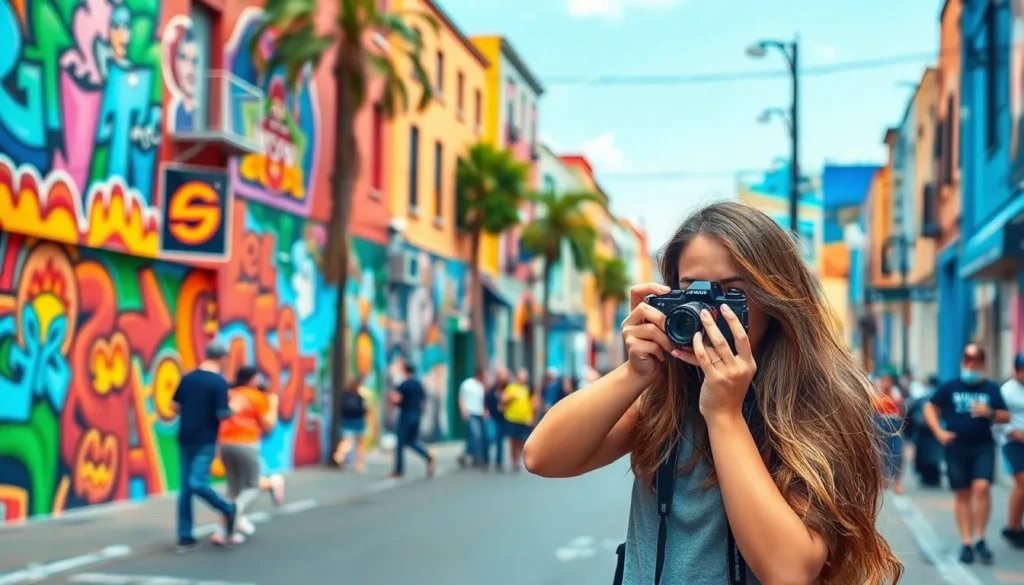Traveling is one of life’s greatest adventures, but for women, it can sometimes feel like navigating a minefield in stilettos. With the thrill of exploring new cultures comes the responsibility of staying safe. It’s not just about packing the perfect outfits; it’s about arming yourself with knowledge and strategies to keep those adventures worry-free.
Table of Contents
ToggleUnderstanding Female Travel Safety
Safety remains a crucial aspect of travel for women, intertwining with the excitement of exploring new destinations. Preparing properly can lead to a more enjoyable experience.
Importance of Travel Safety for Women
Traveling poses unique safety challenges for women. Prioritizing safety enhances the overall travel experience. Awareness of surroundings plays a vital role in staying safe. Planning ahead, like researching destinations, helps women anticipate potential issues. Utilizing technology, such as safety apps, offers additional security. Building a support network, including local contacts or fellow travelers, contributes to a sense of security while on the road.
Common Safety Concerns for Female Travelers
Common safety concerns often include harassment, theft, and navigating unfamiliar areas. Harassment can occur in crowded places or public transportation, making vigilance essential. Theft poses risks, especially in tourist-heavy locations. Women travelers may face increased scrutiny in certain cultures, impacting their comfort. Understanding cultural norms aids in mitigating risks. Using hotel services for safe transport options adds an extra layer of protection.
Tips for Ensuring Safety While Traveling

Prioritizing safety during travels enhances the overall experience. Implementing effective strategies and being aware of surroundings can significantly reduce risks.
Researching Destinations
Understanding a destination’s safety landscape is essential. Review recent travel advisories from the U.S. Department of State for updates on safety concerns. Engage with online forums and read reviews by other female travelers for firsthand accounts. Investigate local laws and customs to avoid unintentional offenses. Exploring local transportation options in advance can facilitate safer travels. Identify areas known for higher crime rates and plan routes accordingly. Familiarizing oneself with emergency contacts, including local authorities and embassies, serves as a critical safety measure.
Packing Smart and Safe
Packing strategically contributes to safety on the road. Choose lightweight and versatile clothing to ease movement in various settings. Include a personal safety alarm or whistle for emergencies, as these simple tools can deter unwanted attention. Security travel pouches can safeguard valuables while allowing easy access. Opt for clothing with built-in hidden pockets to reduce the likelihood of theft. Always carry a copy of important documents, such as passports and ID, which can simplify reporting if lost. Useful items like portable chargers support communication, helping to stay connected whenever necessary.
Navigating Different Cultures
Traveling in different cultures requires awareness of local customs and practices. Understanding cultural norms enhances safety and fosters respectful interactions. Each region has its unique values and expectations, influencing behaviors and attire. For example, some countries encourage modest dress, while others promote more casual clothing. Engaging with local resources, such as guides or informative websites, can help clarify these cultural differences. Learning a few key phrases in the local language often eases communication and shows respect towards locals.
Understanding Cultural Norms
Cultural norms shape interactions and experiences during travel. Respect for these customs reduces misunderstandings. Researching etiquette, local laws, and acceptable behaviors can prevent uncomfortable situations. Some cultures expect women to maintain a low profile, while others celebrate independence. Observing local women offers valuable insights into navigating social situations. Additionally, joining local tours or group activities facilitates connections while adhering to cultural expectations.
Locating Safe Spaces
Finding safe spaces fosters peace of mind while exploring unfamiliar areas. Identifying reputable establishments, such as hotels or cafes, enhances feelings of security. Neighborhoods known for being tourist-friendly often provide safer environments. Using mobile apps or websites to check safety ratings of areas can aid in making informed decisions. Networking with fellow travelers through forums or social media can yield recommendations for trustworthy spots. Locating safe transport options, like registered taxis or ride-sharing services, further reduces risks and encourages enjoyable outings.
Utilizing Technology for Safety
Technology plays a crucial role in enhancing safety for female travelers. Utilizing various tools can significantly improve travel experiences.
Safety Apps and Tools
Safety apps offer valuable features that help ensure security on the go. Applications like SafeTrek and bSafe allow users to alert authorities with just a tap. Other options like Life360 enable location sharing with trusted contacts, providing peace of mind. Travelers can also access maps that indicate safe areas, enhancing situational awareness. Using these tools consistently reduces the risks associated with navigating unfamiliar places. Travelers often find that checking reviews of these apps, ensuring they’re well-rated, adds an extra layer of reassurance.
Keeping Emergency Contacts Accessible
Accessibility of emergency contacts is vital for effective safety measures. Storing contacts in mobile devices under clear labels aids quick retrieval during emergencies. Notably, travelers should keep local emergency numbers, such as police and consulates, readily available. Creating a single document with essential contacts and sharing it with trusted friends or family proves beneficial. This proactive step ensures that support is only a phone call away. Additionally, some travelers prefer to carry printed copies of emergency contacts for situations where technology fails. Keeping these details organized enhances overall travel safety.
Traveling as a woman can be an enriching experience filled with adventure and discovery. Prioritizing safety not only enhances enjoyment but also empowers women to explore the world with confidence. By being prepared and informed about potential risks and local customs, female travelers can navigate unfamiliar territories more easily. Utilizing technology and networking with others further strengthens their safety net. With the right strategies in place, women can embrace their journeys, create unforgettable memories, and inspire others to do the same. Empowerment through knowledge is key to safe and fulfilling travels.








